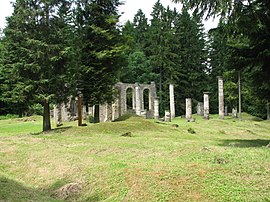Ornes
| Ornes | ||
|---|---|---|

Ruins of the Ornes church
|
||
|
||
| Coordinates: 49°15′13″N 5°28′21″E / 49.2536°N 5.4725°ECoordinates: 49°15′13″N 5°28′21″E / 49.2536°N 5.4725°E | ||
| Country | France | |
| Region | Grand Est | |
| Department | Meuse | |
| Arrondissement | Verdun | |
| Canton | Charny-sur-Meuse | |
| Intercommunality | Communauté de communes de Charny-sur-Meuse | |
| Government | ||
| • Mayor (2001–2008) | Charles Saint-Vanne | |
| Area1 | 18.52 km2 (7.15 sq mi) | |
| Population (2012)2 | 6 | |
| • Density | 0.32/km2 (0.84/sq mi) | |
| Time zone | CET (UTC+1) | |
| • Summer (DST) | CEST (UTC+2) | |
| INSEE/Postal code | 55394 /55150 | |
| Elevation | 209–327 m (686–1,073 ft) (avg. 250 m or 820 ft) |
|
|
1 French Land Register data, which excludes lakes, ponds, glaciers > 1 km² (0.386 sq mi or 247 acres) and river estuaries. 2Population without double counting: residents of multiple communes (e.g., students and military personnel) only counted once. |
||
1 French Land Register data, which excludes lakes, ponds, glaciers > 1 km² (0.386 sq mi or 247 acres) and river estuaries.
Ornes is a commune in the Meuse department in Grand Est in north-eastern France. The village is one of the nine French villages destroyed in the First World War and one of six that was never rebuilt. It's now a memorial place.
Even though a few houses and a handful of permanent residents remain, the village is classified as having "died for France".
Ornes is located on departmental road 24, about 12 km to the north-east of Verdun. The source of the Orne river is in the commune.
The village is on the border of the Verdun forest where thousands of shells fell during World War I.
...
Wikipedia



